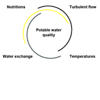To avoid contamination within a potable water supply system, specific procedures must be followed. This is particularly important in facilities housing people with weakened immune systems, such as hospitals, retirement homes and care homes.
In order to minimise the expense required to remove the contaminants from the outset, it is necessary to avoid the introduction of impurities as far as possible during installation or repair work. To do this, all system components comprising the potable water supply system are to be transported and stored in such a way that internal contamination from earth, mud, dirty water, pathogens, small animals, etc. can be reliably avoided during installation.
From the outset, it is essential to avoid a lack of water exchange in unused pipelines (e.g. guest toilet, outside tap), otherwise there is an increased risk of microbiological contamination.
Special-use buildings, such as hospitals, retirement homes, kindergartens, schools, also require a hygiene plan. This hygiene plan must contain information and instructions for the increased requirements of the maintenance measures and actions to be taken in the event of faults and incidents.


